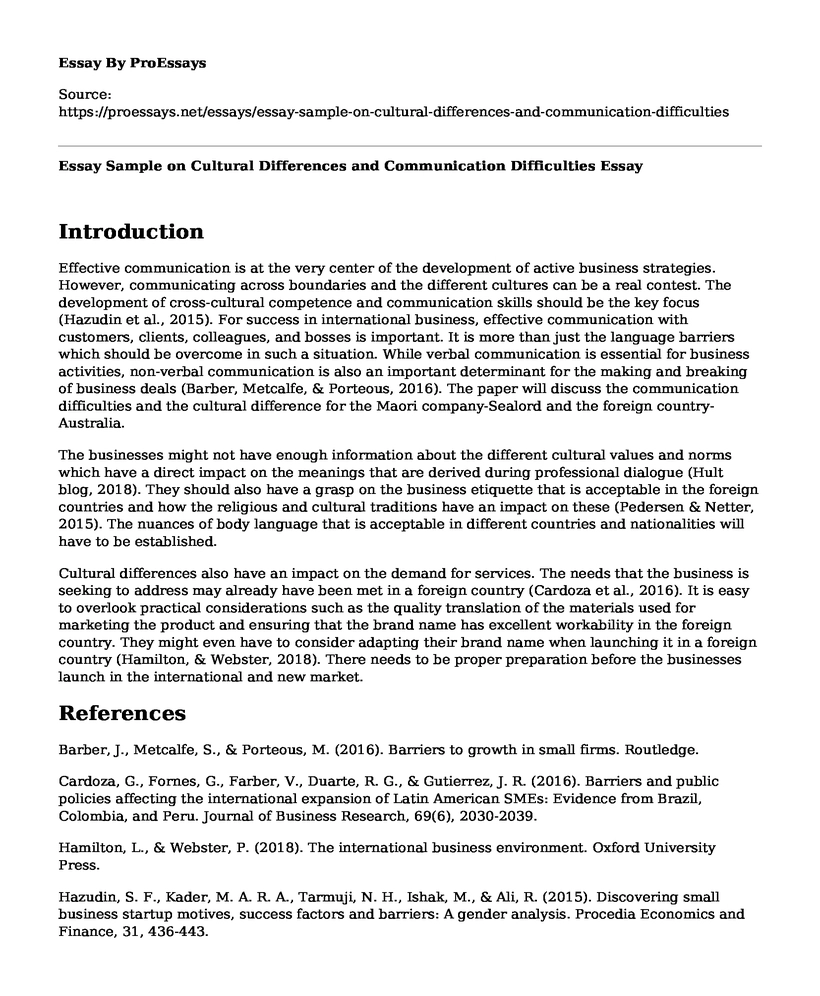Introduction
Effective communication is at the very center of the development of active business strategies. However, communicating across boundaries and the different cultures can be a real contest. The development of cross-cultural competence and communication skills should be the key focus (Hazudin et al., 2015). For success in international business, effective communication with customers, clients, colleagues, and bosses is important. It is more than just the language barriers which should be overcome in such a situation. While verbal communication is essential for business activities, non-verbal communication is also an important determinant for the making and breaking of business deals (Barber, Metcalfe, & Porteous, 2016). The paper will discuss the communication difficulties and the cultural difference for the Maori company-Sealord and the foreign country- Australia.
The businesses might not have enough information about the different cultural values and norms which have a direct impact on the meanings that are derived during professional dialogue (Hult blog, 2018). They should also have a grasp on the business etiquette that is acceptable in the foreign countries and how the religious and cultural traditions have an impact on these (Pedersen & Netter, 2015). The nuances of body language that is acceptable in different countries and nationalities will have to be established.
Cultural differences also have an impact on the demand for services. The needs that the business is seeking to address may already have been met in a foreign country (Cardoza et al., 2016). It is easy to overlook practical considerations such as the quality translation of the materials used for marketing the product and ensuring that the brand name has excellent workability in the foreign country. They might even have to consider adapting their brand name when launching it in a foreign country (Hamilton, & Webster, 2018). There needs to be proper preparation before the businesses launch in the international and new market.
References
Barber, J., Metcalfe, S., & Porteous, M. (2016). Barriers to growth in small firms. Routledge.
Cardoza, G., Fornes, G., Farber, V., Duarte, R. G., & Gutierrez, J. R. (2016). Barriers and public policies affecting the international expansion of Latin American SMEs: Evidence from Brazil, Colombia, and Peru. Journal of Business Research, 69(6), 2030-2039.
Hamilton, L., & Webster, P. (2018). The international business environment. Oxford University Press.
Hazudin, S. F., Kader, M. A. R. A., Tarmuji, N. H., Ishak, M., & Ali, R. (2015). Discovering small business startup motives, success factors and barriers: A gender analysis. Procedia Economics and Finance, 31, 436-443.
Pedersen, E. R. G., & Netter, S. (2015). Collaborative consumption: business model opportunities and barriers for fashion libraries. Journal of Fashion Marketing and Management, 19(3), 258-273.
11 Biggest Challenges of International Business in 2017 Hult Blog. (2018, October 11). Retrieved from https://www.hult.edu/blog/international-business-challenges/
Cite this page
Essay Sample on Cultural Differences and Communication Difficulties. (2022, Dec 22). Retrieved from https://proessays.net/essays/essay-sample-on-cultural-differences-and-communication-difficulties
If you are the original author of this essay and no longer wish to have it published on the ProEssays website, please click below to request its removal:
- Effects of Both Political and Economic Changes on Women and Ethnic Minorities
- Essay Sample on Native American Treaties: Reserved Rights Doctrine
- Essay on Changing Society: Charitable Activism for a Sustainable Future
- Essay on Gender Roles in Ancient Greek Tragedy: A Look at Women in Sophocles' Antigone
- Athletics and Social Life: Examining the Impact of College Athletics - Essay Sample
- Essay Example on Embracing Cultural Diversity in Nursing: Exploring Transcultural Nursing
- Free Paper Sample on IPV: A Global Public Health Concern







